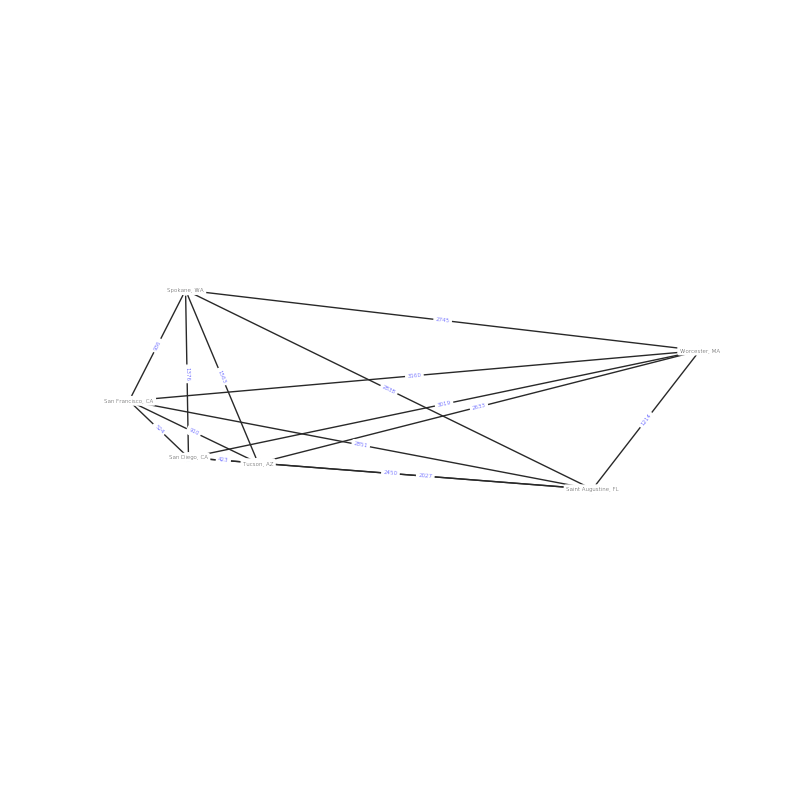Cities¶
miles_graph() returns an undirected graph over the 128 US cities from the datafile miles_dat.txt. The cities each have location and population data. The edges are labeled with the distance between the two cities.
This example is described in Section 1.1 in Knuth’s book (see [1] and [2]).
References.¶
| [1] | Donald E. Knuth, “The Stanford GraphBase: A Platform for Combinatorial Computing”, ACM Press, New York, 1993. |
| [2] | http://www-cs-faculty.stanford.edu/~knuth/sgb.html |

Out:
Loaded miles_dat.txt containing 128 cities.
digraph has 128 nodes with 8128 edges
Subgraph has 6 nodes with 15 edges
['San Diego, CA', 'San Francisco, CA', 'Worcester, MA', 'Spokane, WA', 'Tucson, AZ', 'Saint Augustine, FL']
# Based on example from NetworkX
import re
import sys
import matplotlib.pyplot as plt
import networkx as nx
import grave
def miles_graph():
""" Return the cites example graph in miles_dat.txt
from the Stanford GraphBase.
"""
# open file miles_dat.txt.gz (or miles_dat.txt)
import gzip
fh = gzip.open('knuth_miles.txt.gz', 'r')
G = nx.Graph()
G.position = {}
G.population = {}
cities = []
for line in fh.readlines():
line = line.decode()
if line.startswith("*"): # skip comments
continue
numfind = re.compile("^\d+")
if numfind.match(line): # this line is distances
dist = line.split()
for d in dist:
G.add_edge(city, cities[i], weight=int(d))
i = i + 1
else: # this line is a city, position, population
i = 1
(city, coordpop) = line.split("[")
cities.insert(0, city)
(coord, pop) = coordpop.split("]")
(y, x) = coord.split(",")
G.add_node(city)
# assign position - flip x axis for matplotlib, shift origin
G.position[city] = (-int(x) + 7500, int(y) - 3000)
G.population[city] = float(pop) / 1000.0
return G
if __name__ == '__main__':
G = miles_graph()
print("Loaded miles_dat.txt containing 128 cities.")
print("digraph has %d nodes with %d edges"
% (nx.number_of_nodes(G), nx.number_of_edges(G)))
cities = ['San Diego, CA',
'San Francisco, CA',
'Saint Augustine, FL',
'Spokane, WA',
'Worcester, MA',
'Tucson, AZ']
# make subgraph of cities
H = G.subgraph(cities)
print("Subgraph has %d nodes with %d edges" % (len(H), H.size()))
print(H.nodes)
# draw with grave
plt.figure(figsize=(8, 8))
# create attribute for label
nx.set_edge_attributes(H,
{e: G.edges[e]['weight'] for e in H.edges},
'label')
# create stylers
def transfer_G_layout(network):
return {n: G.position[n] for n in network}
def elabel_base_style(attr):
return {'font_size': 4,
'font_weight': .1,
'font_family': 'sans-serif',
'font_color': 'b',
'rotate': True, # TODO: make rotation less granular
}
elabel_style = grave.style_merger(grave.use_attributes('label'),
elabel_base_style)
grave.plot_network(H, transfer_G_layout,
node_style=dict(node_size=20),
edge_label_style=elabel_style,
node_label_style={})
# scale the axes equally
plt.xlim(-5000, 500)
plt.ylim(-2000, 3500)
plt.show()
Total running time of the script: ( 0 minutes 0.081 seconds)